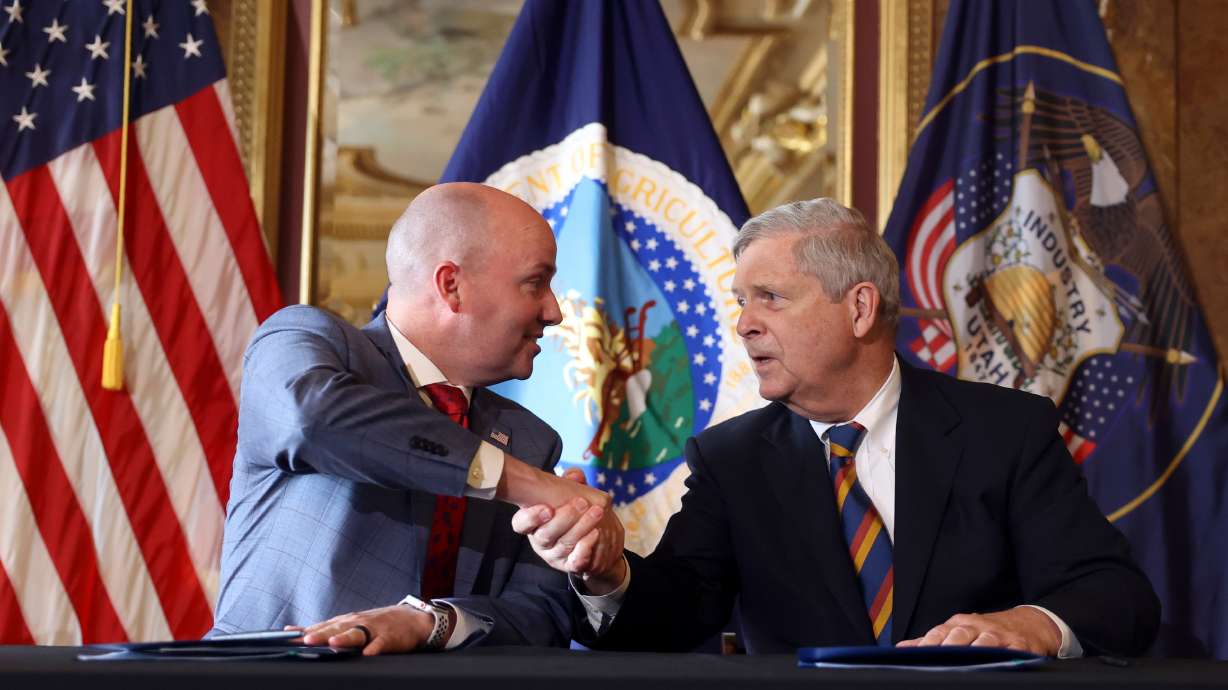Estimated read time: 4-5 minutes
This archived news story is available only for your personal, non-commercial use. Information in the story may be outdated or superseded by additional information. Reading or replaying the story in its archived form does not constitute a republication of the story.
SALT LAKE CITY — Having healthy, thriving forests in Utah and vibrant watersheds are akin to having a prolific vegetable garden that delivers well into the fall.
It's not enough to just look at it and appreciate its value; it takes work keeping the insects, the thieving birds and the weeds away and ensuring an adequate water supply.
That "work" is what the U.S. Department of Agriculture's Forest Service Shared Stewardship program with Utah is all about — bringing a variety of partners together to develop and protect healthy forests and safeguard critical watersheds that provide the overwhelming majority of Utah's water supply.
"This is a document that's going to allow us to share decisions as it should. This is a document that's going to encourage us to look at those large landscape-scale projects and figure out how to get the things done. This is a document that still allows us to coordinate those investments so that we can assure our taxpayers, at whatever level, that their resources are being used in the most efficient and effective way," said U.S. Secretary of Agriculture Tom Vilsack.
"This is an opportunity for us to minimize to the extent possible the risk that is real of wildfire, and to be able to respond collaboratively to try to minimize this risk."
Vilsack was in Utah to speak at Utah State University's commencement Thursday and to participate with Utah Gov. Spencer Cox in the renewal of the Shared Stewardship agreement during a ceremonial event in the state Capitol's Gold Room attended by a bevy of Forest Service employees, state agency representatives and county commissioners.
Related:
"(Through) the shared stewardship agreement, the state and USDA together have invested $22 million in improving the health of our forests in Utah, and we really are just getting started," Cox said, adding those forest treatments carried out so far have helped protect the water supply for 2 million residents.
Additional work, Cox said, includes addressing watershed improvements in the Fish Lake National Forest as well as targeting insect and disease mortality.
The signing event builds on the Shared Stewardship agreement inked in 2019 between then-Utah Gov. Gary Herbert and the U.S. agriculture secretary at the time, Sonny Perdue. At that signing, Utah was only the third state in the country to endorse the cooperative arrangement, but now a majority of states are on board and this most recent agreement in Utah also brings on a new partner, the USDA's Natural Resources Conservation Service.
The cooperative agreement has funneled millions into shovel-ready projects to build forest resiliency and reduce wildfire risks in areas targeting the Upper Provo River watershed and the Wasatch canyons project. In the canyons, the project focused on the removal of standing and downed Englemann spruce.
With wildfires clobbering the West, razing entire towns and killing people, ensuring healthy forests is critical for landscapes, livelihoods and water supplies.
The Interior Department noted in a report that 80% of the nation's water supply comes from forested lands, with billions of water storage and delivery infrastructure at risk or already ruined.
Utah's Dollar Ridge Fire in 2018 forced a $28 million upgrade at the Duchesne Valley Treatment Plant after debris and sediment washed into Starvation Reservoir.
The upgrade featured an enhanced filtration system that would be more protective of water quality in the event of a future wildfire that leads to debris flows.
In 2020, the Range Fire came within a couple hundred yards of a critical water treatment plant in Orem that serves hundreds of thousands of people.
Over four years, partners in the stewardship program have successfully treated over 54,000 acres, funding 31 projects.
Due to drought, Utah's wildfire season is off to an early and disturbing start.
The latest drought update issued by the Utah Division of Wildlife Resources says there have been 97 wildfires in Utah that have burned approximately 256 acres. Out of the 97 wildfires, this year 88 of them have been human-caused. Fire officials are fearing the worst, but are hopeful the protective work done so far will help.
"It's been huge," said Brian Steed, executive director of the Utah Department of Natural Resources, describing program impacts after the ceremonial signing had concluded.
"It's been a game-changer with our federal partners and others," he said, adding the narrative that states and the federal government are constant combatants at odds with each other is belied through programs like Shared Stewardship.











